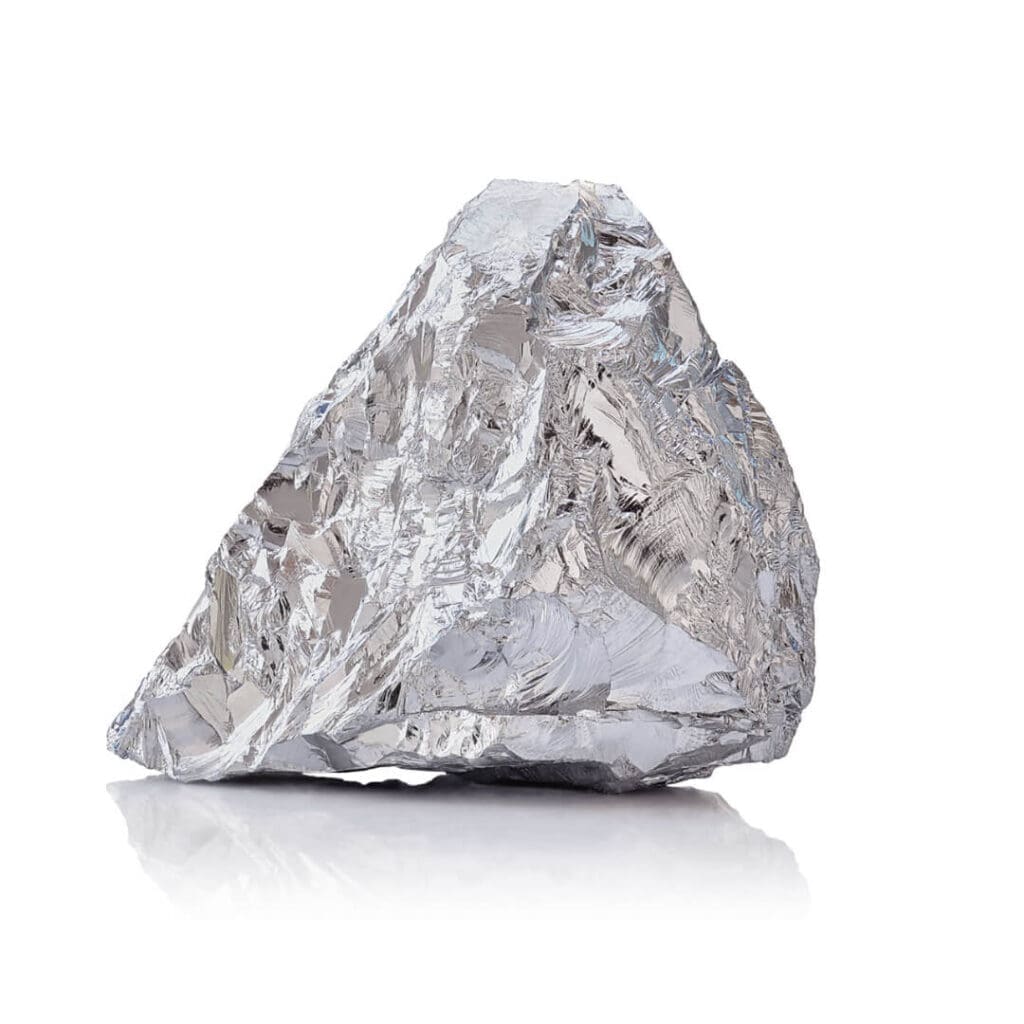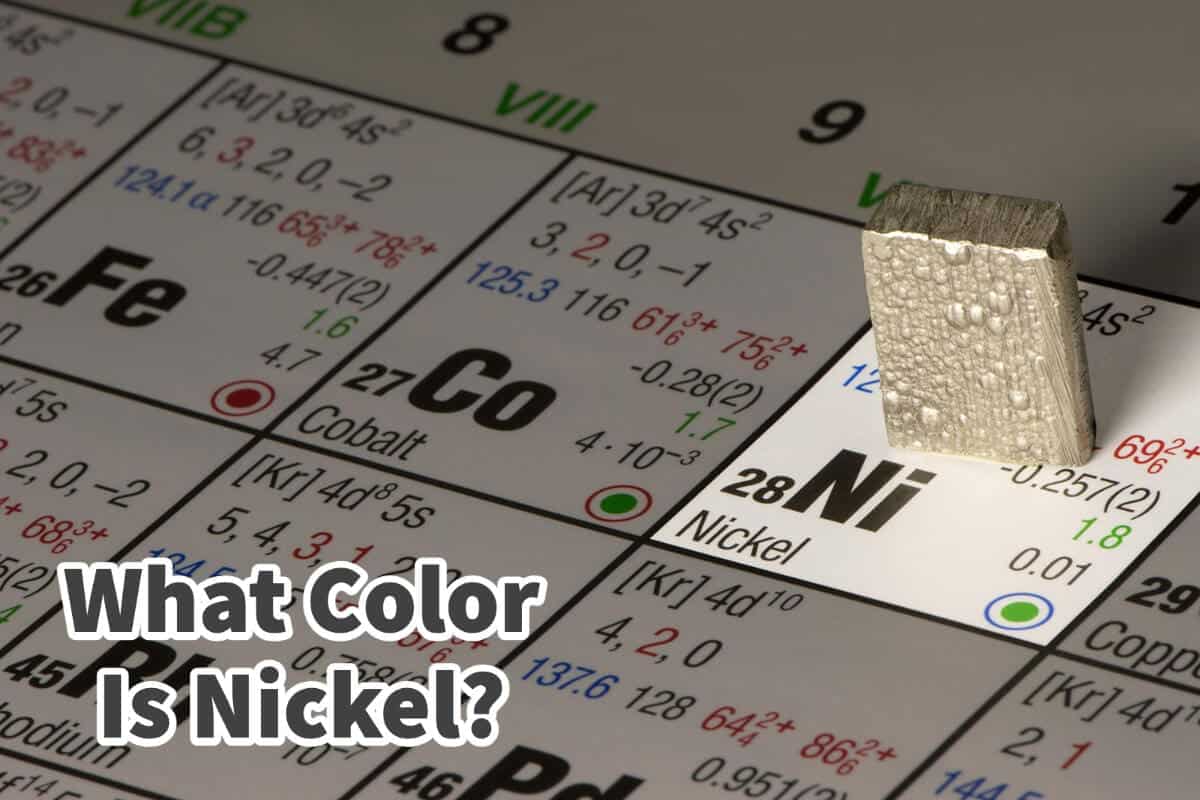Nickel continues to be a popular color to be used for home decor and home furniture. It is interesting to explore precisely what color nickel is.
Nickel is a color that has a silvery-white lustrous finish that has a slightly golden tint. The color can sometimes vary, which adds to its allure and mystery because it is a metal. The color can not wholly match the paint finishes, but some finishes can be referenced to the nickel color. Read on to explore more about nickel’s color and properties.
Table of Contents
- About The Nickel Color
- Nickel Is A Transition Metal With A Silvery White Color
- The Nickel Color Is Popular In Home Decor And Furnishings
- Stainless Steel Vs. Nickel Colors Explored
- Frequently Asked Questions About Nickel And The Nickel Color
- Related Content
About The Nickel Color
Nickel is a chemical element with the symbol Ni and atomic number 28. It is a silvery-white lustrous metal with a slight golden tint. The color of nickel can vary depending on its finish, but its natural appearance is typically a shiny silver.

Nickel is silver in color due to its physical properties. Nickel is a highly reflective metal with a high polishability, contributing to its shiny appearance. It also has a high melting point and density, making it a durable and sturdy metal.
HEX, RGB, And Pantone Reference Colors For Nickel
Even though nickel is a metal color, you can not match it precisely with a HEX, RGB, and Pantone color, but some colors are considered closer to the nickel color than others. Here are some of the color references:
- The HEX color code for nickel is #737373
- The RGB code is (115, 115, 115)
- The Pantone color code is 7545 C.
Nickel Is A Transition Metal With A Silvery White Color
Nickel is a transition metal, which means it is in the center of the periodic table between metals and non-metals. It belongs to the same family as iron, cobalt, and copper.

Nickel is known for its strength and durability, and it is commonly used in producing stainless steel, alloys, and other materials that require resistance to corrosion and wear.
Nickel is a silvery-white lustrous metal with a slight golden tint. Its natural appearance is typically a shiny silver color.
The Nickel Color Is Popular In Home Decor And Furnishings
Nickel is a popular material for many applications in home decor and furnishings. Its neutral color and sleek appearance make it versatile for various styles and aesthetics.
Here are some of the ways nickel is used in home decor:
- Cabinet Hardware – Nickel knobs, handles, and pulls are popular for kitchen and bathroom cabinets.
- Lighting Fixtures – Nickel is commonly used for lamp bases, shades, and other parts of light fixtures.
- Furniture Accents – Nickel can be used as accents on furniture legs, drawer pulls, and other decorative elements.
- Tableware – Nickel-plated tableware, such as silverware and serving dishes, is famous for special occasions and formal dining.
- Bathroom Accessories – Nickel is commonly used for towel racks, toilet paper holders, and other accessories.
- Picture Frames – Nickel picture frames provide a sleek and modern decor style.
- Mirrors – Nickel is often used for bathroom frames and other decorative mirrors.
- Door Hardware – Nickel door knobs, handles, and hinges provide a durable and stylish option for interior and exterior doors.
Nickel is a silvery-white lustrous metal with a slight golden tint. Its natural appearance is typically a shiny silver color. Nickel is a transition metal known for its strength and durability. It is commonly used in producing stainless steel, alloys, and other materials that require resistance to corrosion and wear.
In-home decor and furnishings, nickel is a versatile material used for various applications, from cabinet hardware to door knobs and handles. Its neutral color and sleek appearance make it famous for many different decor styles.
Stainless Steel Vs. Nickel Colors Explored
Stainless steel and nickel are widely used in various industries and applications, from household products to heavy-duty machinery. Both materials offer unique properties and characteristics that make them valuable for different purposes.

Understanding the differences and similarities between stainless steel and nickel can help select the suitable material for a particular application.
In this exploration, we will compare and contrast the properties of stainless steel and nickel, including their composition, corrosion resistance, durability, appearance, magnetism, melting point, density, conductivity, cost, and uses.
By exploring these properties, we hope to provide a comprehensive understanding of the similarities and differences between these two materials and ultimately help make informed decisions when selecting the suitable material for a specific application.
| Property | Stainless Steel | Nickel |
|---|---|---|
| Composition | An alloy of iron, carbon, and other metals | Pure metal element |
| Corrosion resistance | Highly resistant to corrosion | Highly resistant to corrosion |
| Durability | Very durable and strong | Very durable and strong |
| Appearance | A shiny, silver-gray color | Shiny, silver-white color with a slight golden hue |
| Magnetism | It can be magnetic or non-magnetic, depending on the alloy | Non-magnetic |
| Melting point | High melting point | High melting point |
| Density | High density | High density |
| Conductivity | Poor electrical and thermal conductivity | Good electrical and thermal conductivity |
| Cost | Relatively inexpensive | More expensive than stainless steel |
| Uses | Widely used in industrial and household applications | Used in a variety of applications, including alloys, plating, and batteries |
As shown in the table above, both stainless steel and nickel have many similar properties, including high durability, resistance to corrosion, and a high melting point.
However, some key differences exist between the two materials, such as that stainless steel is an alloy while nickel is a pure metal element. Additionally, nickel has a slightly warmer color than stainless steel and is non-magnetic, while some stainless steel alloys can be magnetic.
Overall, both stainless steel and nickel are valuable materials that are widely used in many different applications.
Mondoro can help you with your nickel or stainless steel needs for home decor and home furnishing manufacturing.
To learn more about how Mondoro can help you create, develop, and manufacture excellent home decor and home furniture products – in nickel – don’t hesitate to contact me, Anita. Check out my email by clicking here or become a part of our community and join our newsletter by clicking here.
Mondoro gives out a FREE Lookbook to anyone interested. You can receive a copy of our latest Lookbook by clicking here.
Listen to our Podcast called Global Trade Gal. You can find it on all major podcast platforms. Try out listening to one of our podcasts by clicking here.
Subscribe to our Mondoro Company Limited YouTube Channel with great videos and information by clicking here.
Frequently Asked Questions About Nickel And The Nickel Color
What color is natural, unpolished nickel?
Natural, unpolished nickel is typically a matte silver-gray color.
Does nickel have any other colors?
Nickel can take on different colors depending on its finish or treatment, such as black nickel, brushed nickel, or satin nickel.
What is the difference between polished and satin nickel?
Polished nickel has a shiny, reflective surface, while satin nickel has a more muted, brushed finish.
Is nickel a shiny or dull metal?
Nickel can be both shiny and dull, depending on its finish
Does nickel rust or corrode over time?
Does nickel rust or corrode over time? Nickel is resistant to corrosion and does not rust, making it a popular choice for many applications.
What metals are similar in color to nickel?
Metals such as stainless steel, aluminum, and silver can be similar in color to nickel.
Can nickel be painted or coated in other colors?
Yes, nickel can be painted or coated in other colors, but this will alter its natural appearance.
Is nickel hypoallergenic?
Nickel is not hypoallergenic and can cause allergic reactions in some people.
Can nickel be recycled?
Can nickel be recycled? Yes, nickel is a recyclable material and can be used to make new products.
What is the difference between nickel and chrome?
Nickel and chrome are shiny metals, but nickel has a slightly warmer, golden hue, while chrome has a bluer tint.
Related Content
What Is The Brass And Bronze Material Used In Home Decor Products?
Brass and bronze are copper alloys; brass is copper and zinc, and bronze material is copper and tin. They both look similar but have different properties and uses. When brass or bronze is made into home decor products, they are often sand cast or use a lost wax or investment mold technique. Each production method has different uses and prices that can affect the overall production.
You can discover more by reading What is the Brass and Bronze Material Used In Home Decor Products? by clicking here.
Are Brass And Nickel The Same?
Both Brass and Nickel are metal finishes that can be electroplated or plated. They contain copper and can be made into unique, exciting looks and finishes. Because of their versatility, they remain popular metals and finishes for various products and uses.
You can find out more by reading our blog Are Brass And Nickel The Same? by clicking here.
Brass Plated Vs. Chrome Plated Metals Explained
Brass and Chrome are plated on metal using the same electroplating method, but the look and finish differ. Brass will be warm golden, whereas Chrome will look like shiny silver metal. Both are excellent electroplated treatments, and choosing one can also depend on the look you want for a specific product.
You can discover more by reading Brass Plated Vs. Chrome Plated Metals Explained by clicking here.

